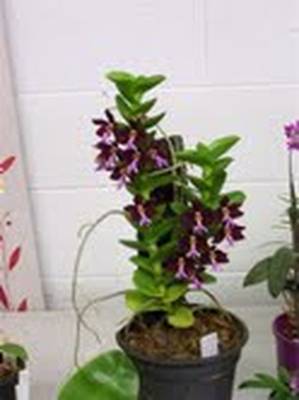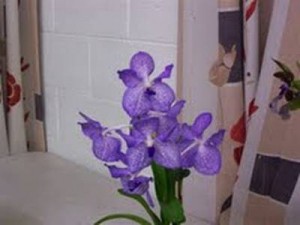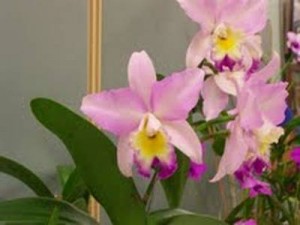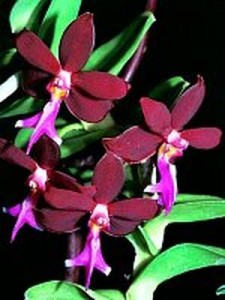Orchid News – May 2012
Home > Orchid News > 2012
Index
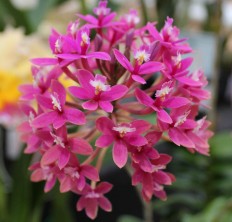
Calendar
- 27-29 Apr Autumn Show.
- 3 May Steve Clemesha – local native orchids
- 20 May Gordon/Brian’s workshop
- 7 June Murray Shergold – Ansellia africana
- 16 June Walk to see some native orchids
- 5 July Peter King – growing Cymbidiums.
May Meeting
At the May meeting, Steve Clemesha will be talking about the orchids which are native to this area. Steve is an expert on the flora of the area.
He will be taking us on an easy walk in June to see a few of these orchids.

A Miltassia on our monthly competition bench in April. Thanks to Clem Murray for the photos included in this newsletter.
Secretary
Unfortunately Sherill Harrison is no longer able to continue with her duties as secretary and has reluctantly resigned. Carole Davis has volunteered to post the newsletters, and a new member, Bronwen Fox, has agreed to do the other secretary duties temporarily.
On behalf of the society I would like to thank Sherill for all her work on behalf of the society, and to wish her well for a speedy recovery.
Committee Report
The committee meet as usual at Mangrove Jacks on the Tuesday after our general meeting. We discussed Sherill’s retirement as secretary – see above – arrangements for the show, and our involvement in the up-coming Agricultural Show.
Coffs Harbour Agricultural Show
The Coffs Harbour Show is being held on 12th and 13th May at the Showgrounds. We will have an orchid display as usual.
We will need a few people to bring in some plants on Friday afternoon 11th May for our display, and we will need a few people to put in some time supervising and answering questions.
Workshop
A reminder that the next workshop at Gordon’s – 26 Pullen Street, Woolgoolga is on 20th May at 9.30 am. All are welcome.
New Sponsor
Coffs Harbour Produce in June Street has agreed to be a sponsor for our society. They have good supplies of fertilisers, insecticide and fungicides for growing orchids. They are one of the few places where you can by Campbell’s Yellow in Coffs Harbour.
They also have a good range of products for the general garden and farms.
The generosity of our sponsors enables us to keep our membership fees low while providing the services we do for our members. Please support our sponsors so they will continue to support us.
Robert Bisetto’s Talk
Robert and George are orchid enthusiasts who share their love of orchids with other orchid growers. The products they sell are products they have used themselves.
Products they spoke about were
- An in-line feeder filled with Magamp slow release fertiliser. This delivers small amounts of fertiliser regularly. It is strongly recommended
- Vitarich fertiliser is used by many growers, but a caution – don’t use it on sphagnum moss
- Peters fertiliser products. These are used extensively by several excellent growers in Sydney.
- Flit sprayer. Has many uses – the brass fittings ensure a long life.
- Oxenone rooting hormone can be used when dividing and re-potting. It promotes strong root growth.
- Hydrogen Peroxide. Has many benefits when used in the garden. Is a disinfectant and can be used as a fungicide and insecticide. They product sold also has some colloidal silver which increases the benefits.
- Suggested that Eco-oil is a good product, but is overpriced. You can get the same benefits from a mixture of canola and eucalyptus oil. It is good as a wetting agent. Neem oil can be used also and successive use produces a systemic effect. This can be mixed with other products like Confidor.
- Recommend use of Metarex for snails and slugs. It is safe for pets.
Our thanks to Robert and George for making the trip to share their ideas with us.
Monthly Display / Competition
A reminder that plants should be benched before 7.15 so that the yellow numbers can be placed by the plants for people to vote for popular plant. Sherrill will put numbers out at 7.15.
Ron Cowling has the voting slips for popular vote.
He also has slips for members who are benching plants. Please remember to put your name on the back of the slip when you are benching your plants.
A reminder too that the table talk will only highlight a few plants. The complete set of results is published in the newsletter each month.
Autumn Show
The Autumn Show will be held here at the Botanic Gardens at the end of the month. We encourage everyone to look at their orchids to see if they have anything in flower that they can enter.
We’ve had a few speakers talking to us about preparing orchids for shows – these talks are reported in our newsletters which can be found on the web site. Copies of our schedule are available from secretary, and it is also available on our website.
All members are encouraged to contribute plants for the show.
Remember too that this year we are broadening the range of orchid plants that we can sell at the sales table. We are not restricted just to flowering plants, but can also sell mature, well established plants. The sales table coordinator will be authorised to reject plants that don’t meet this standard.
We will be seeking volunteers for the roster at our meeting. It takes a lot of work to put on a successful show, but if people are prepared to help then it is easier on everyone.
There is a partial roster included in this newsletter.
Agenda for May Meeting
Welcome, Apologies, Visitors, New members.
Minutes of April meeting – as printed in newsletter
Business Arising
Committee Report – refer to newsletter.
Inwards Correspondence
- Thanks from Orchid Tray Company.
Outwards Correspondence
- Sympathy card
- Thanks to Orchid Tray Company
- Thanks to new sponsor.
Finance Report – as printed in newsletter
Table talk
General business
Guest Speaker – Steve Clemesha
Raffle, popular vote.
John Dominy and John Seden
This is another article about the early days of orchid growing.
Do the names Dominy and Seden ring a bell? As employees of the prominent British nurserymen James Veitch and Sons, they were responsible for many early man-made orchid hybrids.
John Dominy flowered the first two hybrids (a Calanthe and a Cattleya) in 1856 and produced a further 25 hybrids over the next 22 years. Veitch and Sons was the only nursery involved in orchid hybridising for 15 of those years. Paphiopedilum Harrisianum is the only one of Dominy’s hybrids that still occasionally graces our show benches.
John Seden made his first orchid hybrid in 1873, a few years before Dominy retired, and created over 500 more before retiring 30 years later. Angraecum Veitchii, Thunia Veitchii, and Phragmipedium Sedenii are three of his hybrids still in cultivation today. Of course, many other hybridisers were active during John Seden’s time at Veitch’s nursery – in fact over 500 Paphiopedilum hybrids alone had been registered by 1900.
But it’s to John Dominy, as the first orchid hybridiser, that we owe most. As mentioned above, he made 25 of the first orchid hybrids over a period of 22 years. Today, at least that many new orchid hybrids are registered every week!
Thanks to Brian Milligan from North East Melbourne Orchid Society for this information.
Growing Cymbiums – Ray Clement
Cymbidiums are what most people first think of as orchids. This genus is easy to grow and very popular in cooler, temperate climates of New South Wales and the southern states. Shade from hot sun is necessary. A shade- or bush-house covered with 50% shade is ideal. Alternatively, dappled shade from a tree or other plants will suffice. Cymbidiums need plenty of filtered sun to flower well. These orchids will grow well, but rarely flower in full shade. If you don’t have a greenhouse, it may be necessary to move the pot from more sun inwinter to a shadier spot in summer. If you wish to plant cymbidiums in a garden, provide dappled shade or an easterly aspect. Never cover the roots with heavy soil or clay, rather place the plant on top of the soil and mound around it with cymbidium compost.
Temperature. Happy to grow in a wide range of temperatures, cymbidiums will tolerate light frost as long as buds are protected. At the other end of the scale, very hot days are tolerated but plants will benefit from a substantial overnight drop in temperature. This drop in temperature will help initiate flower stems.
Watering. Cymbidiums like to stay damp but not wet. To achieve this, plants may need to be watered daily during hot, dry weather. Watering in the late afternoon/ evening will also help chill the plants. In winter, watering weekly should suffice.
Compost needs to be well aerated and free draining, but still remain damp for a reasonable period. Most cymbidium compost available from specialist nurseries is ideal, but beware of generic brands from supermarkets; these are often of inferior quality. Graded and washed Coconut Husk Chip, such as OrchidMate is a popular media amongst orchid growers. OrchidMate is prewashed and graded; just soak for a few hours and it is ready to use. Treated pine bark or a perlite-based mix is also popular.
Re-potting. Cymbidiums are best re-potted during the cooler months, or if they are flowering, as soon as possible after flowering. To avoid stress to the plants, do not re-pot during summer. If dividing plants, make sure at least 3-4 bulbs are left together. Never reuse compost, and sterilise tools and pre-used pots with bleach or a sugar soap concentrate. After dividing, place plants in a shady area for a few weeks and water sparingly.
Fertiliser. Most effective is water-soluble fertiliser. Use a formula recommended for flowering plants. This can be applied every watering at quarter strength or at recommended strength every third watering. A little slow release fertiliser is OK, but it must be buried in the pot.
Pests & Diseases. Red spider or spider mite is troublesome in summer, especially in warmer climates. Control with a miticide, Pest Oil or predatory mites. Scale is easily controlled by Rogor or Pest Oil. Some disease is prevalent in warm, wet weather. Black spots on leaves are easily controlled by spraying with Mannose or lime water. Bulb rot can be prevented by using Yates Anti Rot. Always use at manufacturers recommended levels, if in doubt seek advice from a nursery or experienced grower. RC
Minutes for April Meeting
Ed welcomed everyone to the April meeting.
Apologies were received from Betty, Margaret, Sherill and Barbara, Pam and Graham.
We welcomed visitors Robert, George, Trish, Carol and Jean. Bronwen was welcomed as a new member.
Minutes of Feb meeting – as printed in newsletter – were approved Mvd Don, Scd Steve.
Business Arising – nil
Committee Report – refer to newsletter.
Inwards Correspondence
- Tinonee Orchids re Sydney International Orchid Fair.
- Australian Orchid Foundation re AOF Essay Prize competition
Outwards Correspondence
- Thanks to sponsors
Finance Report – as printed in newsletter. Mvd Steve, Scd Glenys that report be approved.
Table talk – Bruce spoke about some of the prize winning plants and highlighted special features.
General business
- Show. Members were reminded of the show, set up times and times for receiving plants.
- A further reminder that this year we are selling mature, well-established plants, as well as flowering plants, from the sales table.
- Bruce requested items for the raffle.
The popular vote was won by Ivy Wheeler with her spectacular Trichoglottis. Raffles were won by George, Di and Glenys.
